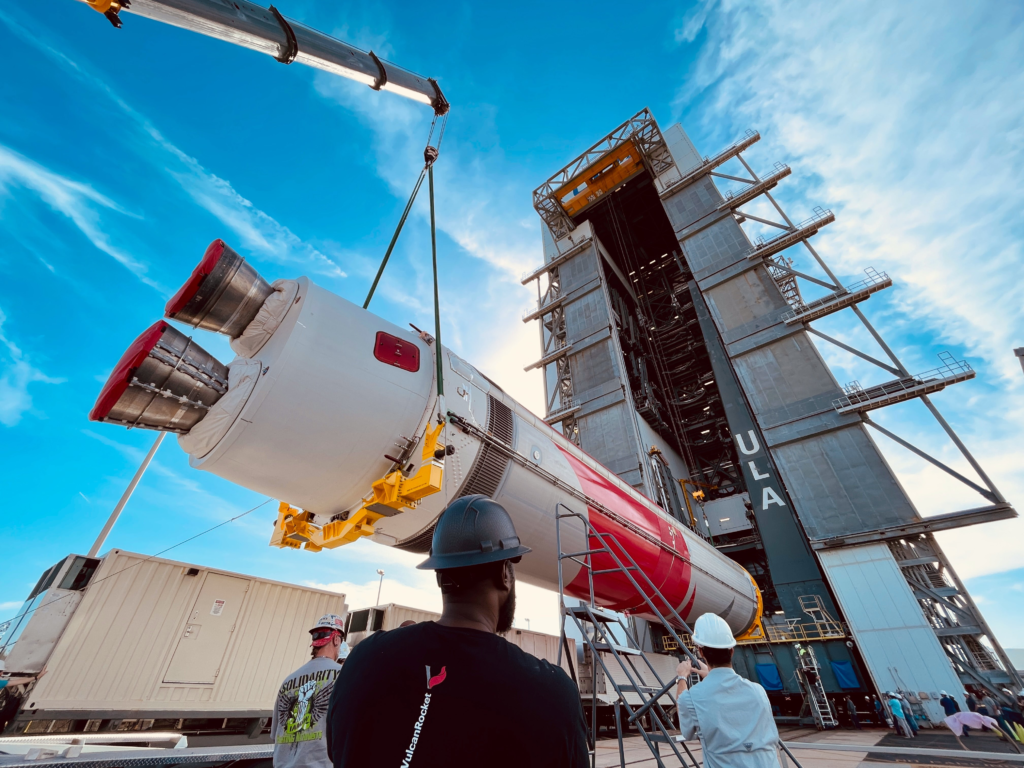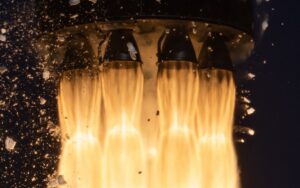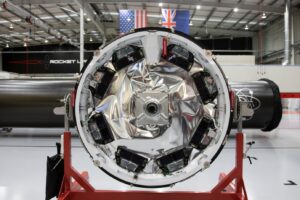
ULA Vulcan SRB Integration Prep, Final Testing, & More
United Launch Alliance is officially on the home stretch toward Vulcan’s first-ever launch. For the last couple of years, a host of issues relating to different hardware and engines has pushed this maiden flight back further and further. While there still is some work and testing necessary, we can expect a launch as early as next month in March, assuming everything goes according to plan.
In the last few weeks, Vulcan’s core stages and equipment arrived at the launch site before being stacked vertically. With this complete, the company will ensure everything is in place before heading over to the pad for a flight readiness firing. This will mark many firsts including two BE-4 flight engines integrated on a rocket and igniting for the first time ever.
As ULA’s other launch vehicles slowly come to the end of their schedule and life, Vulcan is expected to take their place. Even though many next generation launch vehicles are shifting toward either full or partial reusability, ULA is not interested and decided to go the expendable route. Here I will go more in-depth into the recent updates from ULA, when we should expect final testing, integration of the SRBs, and more.
Stacking Complete

Since ULA’s Rocketship arrived they have been working to stack the interstage and upper Centaur stage along with the booster. On the 6th Tory Bruno tweeted saying, “I thought you guys might enjoy a #ToryTimelapse from stacking the Amazing Centaur V last week on top the #VulcanRocket Booster.” Specifically, company technicians successfully stacked the all-American rocket atop the Vulcan Launch Platform (VLP) in the Vertical Integration Facility (VIF) at Cape Canaveral Space Force Station in preparation for the first launch, called Certification Flight-1.
ULA highlighted that teams used processes and procedures evolved from time-proven Atlas V operations to perform the activities known as Launch Vehicle on Stand (LVOS). The work began Jan. 25 when the first stage was trucked to the doorway of the 286-foot-tall (87-meter) VIF for cranes to grapple both ends of the 109.2-foot-long (33.3-meter) stage and then rotate it vertically. Once upright, Vulcan was lifted into the building and secured to the four support fixtures on the VLP. The following day, the 18.8-foot-tall (5.7-meter) interstage was attached to the top of the first stage. This hollow barrel segment connects the Vulcan stages during vehicle stacking operations for launch and encloses the twin RL10 upper stage engines during the boost phase of flight.
The high-performance Centaur V upper stage, measuring 38.5 feet (11.7 meters) in length, was hoisted into place to complete the initial buildup of the first Vulcan rocket, a major milestone that was achieved. In a recent report they said, “Integrated testing of the rocket stages, VLP and ground systems will be conducted within the VIF over the next few weeks before Vulcan rolls out to Space Launch Complex (SLC)-41 to undergo a series of fuel-loading and countdown exercises. The testing culminates with a Flight Readiness Firing (FRF) to practice the full day-of-launch timeline complete with a brief ignition of the rocket’s main engines. This being said, a few days ago on the 9th, when asked about what testing was going on, Tory responded, “Several integrated electrical systems tests are underway, Then Tanking tests.” After the FRF, the rocket will return to the VIF for installation of two solid rocket boosters and its payload for launch. Realistically, if ULA works quickly and the results are as expected, testing could be finished by the end of this month to early March with a launch ready to happen late next month. It could also spill into early April but the most important part is that key components such as the BE-4 engines perform perfectly prior to launch.
In addition to the rocket itself, the payloads also have a big impact on the flight schedule and when Vulcan will lift off. The Peregrine lunar lander for example is responsible for some delays as it got behind due to various reasons. Only a few weeks ago, Astrobotic tweeted mentioning, “Peregrine successfully completed flight acceptance testing!” “Peregrine Mission One’s flight acceptance campaign was completed on schedule and exceeded expectations,” Sharad Bhaskaran, mission director for the lander, said in a company statement. “These tests ultimately proved the quality of Peregrine’s design and workmanship over the full assembly and integration campaign.” At this point, the payload is ready and now is officially waiting for ULA to initiate payload processing. With Peregrine being the primary payload on this mission it marks a good sign for the upcoming launch.
Launch Profile

Now that we know more about Vulcan’s progress and its primary payload, we can take a closer look at this initial mission and what we know. This inaugural mission, known as Certification-1, will deliver two Kuiper prototype broadband satellites into low Earth orbit, send the Astrobotic Peregrine commercial lunar lander to reach the Moon, and carry a Celestis Memorial Spaceflight Payload into deep space. Despite the fact that this mission is Vulcan’s first ever launch, it features quite an ambitious flight profile.
While the company has not released a lot of information on exactly what to expect, we do know some important factors. For one, Vulcan will utilize just two Solid Rocket Boosters or SRBs on the first stage for additional thrust. In this case, Vulcan integrates up to six Northrop Grumman Graphite Epoxy Motor (GEM) 63XL Solid Rocket Boosters (SRBs). The configurations include 0, 2, 4, 6, or even an upgraded variant with SRBs. They are constructed out of a graphite-epoxy composite with the throttle profile designed into the propellant grain. GEM solids supported the Delta II and Delta IV rockets, and the GEM 63 variant has already flown on ULA’s Atlas V. For a trans lunar injection, the payload capacity ranges from 2,300kg with 0 solids to 11,500kg with 6. Since this mission features two its payload capacity will be 6,300kg on a trans lunar injection and 19,000kg to low Earth orbit.
This commercial mission is part of ULA’s requirement to meet the U.S. Space Force certification of its new launch vehicle. Mark Peller, vice president of Major Development, stated “We are committed to ensuring we fly the first certification mission and stay on schedule to achieve U.S. Space Force certification of Vulcan in advance of our first national security space mission in 4th quarter 2023.” The success of this first mission is extremely important for future launch operations. More than 70 Vulcan launches are currently on the manifest, including 38 launches to deploy a majority of Amazon’s Project Kuiper to provide fast, affordable broadband to communities around the world; approximately 20 to 30 missions as the U.S. Space Force’s No. 1 offeror in the National Security Space Launch (NSSL) Phase 2 procurement; and the orbital delivery of Sierra Nevada Corp.’s Dream Chaser reusable spaceplane on cargo resupply missions to the International Space Station.
Vulcan Centaur consists of a single booster stage powered by a pair of BE-4 engines, the high-energy Centaur upper stage powered by two RL10 engines and a 5.4-meter-diameter payload fairing. For additional power at liftoff, up to six solid rocket boosters can be added to the Vulcan Centaur rocket. By making launch more affordable, Vulcan Centaur opens up new opportunities for space capabilities, offering unprecedented flexibility in a single system. From low-Earth orbit to Pluto, the single-core Vulcan Centaur is hoping to do it all. All this being said, maiden rocket launches often have a history of not going perfectly. It’s important to point out however that United Launch Alliance has been building and launching rockets for decades now and has an extremely impressive record.
Recently, Tory Bruno commented, “We could not be more excited to be this close to seeing Vulcan lift off on its inaugural flight. Vulcan’s high energy design coupled with innovative technology provides one scalable system for all missions and will transform the future of space launch. This has been an incredible journey to get to this point and I am so proud of the development team. We look forward to the first flight as Vulcan offers all customers higher performance and greater affordability while continuing to deliver our unmatched reliability.”
Not only did the company makes major upgrades to the rocket, but also its infrastructure at the launch site where this mission will take place. For example, they upgraded the Vertical Integration Facility (VIF) platforms, decks, and crane to accommodate all Atlas and Vulcan configurations. Modifications to SLC-41 to accommodate Vulcan processing and launch included, liquefied natural gas (LNG) ground systems, increasing the fuel and oxidizer storage capacity, and increasing acoustic water suppression system capacity. They also upgraded former solid rocket assembly facility, now known as Spaceflight Processing Operations Center (SPOC), to accommodate Vulcan Launch Platform (VLP) construction and storage. Lastly, the company renovated the rail system from SLC-41 to the SPOC to accommodate Mobile Launch Platform (MLP)/VLP transport and overlapping Vulcan and Atlas launch campaigns.
Conclusion
United Launch Alliance is on track to launch Vulcan for the first time in only a few weeks. After years of development, testing, and delays, the company is at the launch site and has begun final testing. In the coming days, we can expect more testing updates before the final flight readiness firing. We will have to wait and see how it progresses and the impact it has on the space industry.



